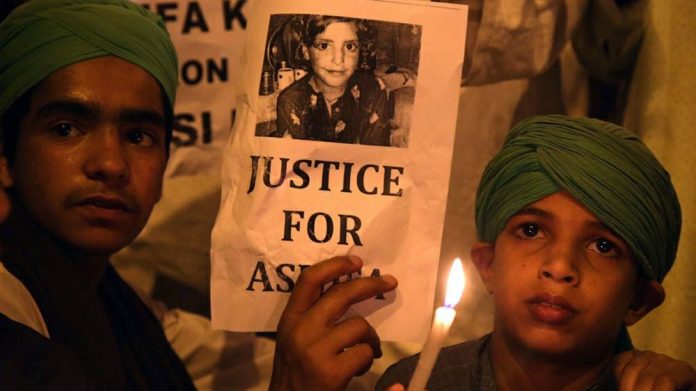Written by: Fatima Iftikhar Chawla (Multan)
Asifa Bano disappeared on 10 January, her family was living in a town around 72km (45 miles) east of Jammu city. On that evening, her mom reviews, Asifa went to the backwoods to bring home the ponies. The ponies returned however Asifa didn’t. The bruised flesh laid in the bushes for several days. To an astonishment, the dead’s can speak, their trails do.
Ms. Naseema educated her significant other. He and a few neighbors began searching for her. Outfitted with spotlights, lights, and tomahawks, they dove deep into the woodland and looked as the night progressed. Be that as it may, they couldn’t discover her.
After two days, on 12 January, the family documented a police protest. Yet, as per Mr. Pujwala, the police were not useful. One of the cops, he asserts, said Asifa probably “stole away” with a kid.
As updates on the wrongdoing spread, Gujjar arranged fights and obstructed a thruway, compelling police to relegate two officials for the inquiry. One of the individuals who was appointed, Deepak Khajuria, was himself captured regarding the wrongdoing. After five days, Asifa’s body was found.
“She had been tormented. Her legs were broken,” reviewed Ms. Naseema, who had hurried to the woods alongside her better half to see the body. “Her nails had turned dark and there were blue and red imprints on her arm and fingers.”
On 23 January, six days after Asifa’s body was discovered, the Jammu and Kashmir boss pastor, Mehbooba Mufti, requested an examination by the wrongdoing branch, a unique unit of the state police.
As indicated by the examiners, Asifa was restricted in a neighborhood sanctuary for a few days and given narcotics that kept her oblivious. The charge sheet affirms that she was “assaulted for quite a long time, tormented and afterward at last killed”. She was choked to death and afterward hit on the head twice with a stone. Sanji Ram, a 60-year-old resigned government official, purportedly arranged the wrongdoing with the assistance of cops Surender Verma, Anand Dutta, Tilak Raj, and Mr. Khajuria.
They accept that the blamed men wished to threaten the Gujjar people group into leaving Jammu. The shepherds utilize open and woods land in Jammu for brushing, which has as of late carried them into strife with some Hindu inhabitants in the area.
“It was about land,” uttered Talib Hussain, an ancestral rights dissident and legal advisor. Mr. Hussain, who drove a dissent on the side of Asifa’s family, affirms he was captured and undermined by neighborhood police.
The wrongdoing has stunned the network, uncovering the separation points between Hindu-lion’s share Jammu and the Muslim-greater part Kashmir valley in a strongly isolated state. The Kashmir valley has a turbulent relationship with India – there has been a furnished revolt in the area contrary to Indian standard since 1989.
Be that as it may, the captures started dissents in Jammu – legal counselors attempted to stop police entering the court to record a charge sheet and two priests from the Hindu patriot Bharatiya Janata Party (BJP) went to a convention on the side of the blamed.
However, the decades old rivalry has demanded the blood of millions of Kashmiris. The death toll might continue with the blood of many innocent Asif’s and Fatima’s as the torture continues at the hands of Hindus in Kashmir. The evidence to the irony of land divided by an invisible Line of Control (LOC) clearly speaks of the rightful eligibility of Kashmiris over it.
“We needed to walk seven miles to cover her in another town,” Mr. Pujwala said. Two of his little girls were ‘slaughtered’ in a mishap a few years back. On his significant other’s request, he received Asifa, the little girl of his brother by marriage.
His significant other portrayed Asifa as a “peeping nightingale” who ran like a “deer”. At the point when they voyaged, she cared for the group.

“That made her the sweetheart of the network,” Ms. Bibi said. “She was the focal point of our universe.”
The noiseless cries may seem unusual elsewhere but in Indian Occupied Kashmiri, it defines the story of every single second, every day.






